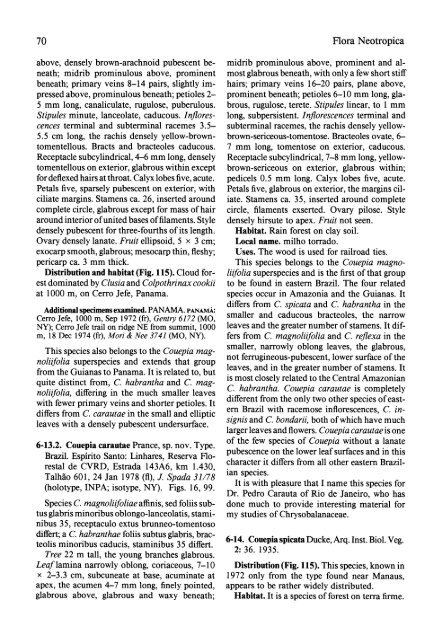flora neotropica - CNCFlora
flora neotropica - CNCFlora
flora neotropica - CNCFlora
You also want an ePaper? Increase the reach of your titles
YUMPU automatically turns print PDFs into web optimized ePapers that Google loves.
70 Flora Neotropica<br />
above, densely brown-arachnoid pubescent be- midrib prominulous above, prominent and alneath;<br />
midrib prominulous above, prominent most glabrous beneath, with only a few short stiff<br />
beneath; primary veins 8-14 pairs, slightly im- hairs; primary veins 16-20 pairs, plane above,<br />
pressed above, prominulous beneath; petioles 2- prominent beneath; petioles 6-10 mm long, gla-<br />
5 mm long, canaliculate, rugulose, puberulous. brous, rugulose, terete. Stipules linear, to 1 mm<br />
Stipules minute, lanceolate, caducous. Inflores- long, subpersistent. Inflorescences terminal and<br />
cences terminal and subterminal racemes 3.5- subterminal racemes, the rachis densely yellow-<br />
5.5 cm long, the rachis densely yellow-brown- brown-sericeous-tomentose. Bracteoles ovate, 6-<br />
tomentellous. Bracts and bracteoles caducous. 7 mm long, tomentose on exterior, caducous.<br />
Receptacle subcylindrical, 4-6 mm long, densely Receptacle subcylindrical, 7-8 mm long, yellowtomentellous<br />
on exterior, glabrous within except brown-sericeous on exterior, glabrous within;<br />
for deflexed hairs at throat. Calyx lobes five, acute. pedicels 0.5 mm long. Calyx lobes five, acute.<br />
Petals five, sparsely pubescent on exterior, with Petals five, glabrous on exterior, the margins cilciliate<br />
margins. Stamens ca. 26, inserted around iate. Stamens ca. 35, inserted around complete<br />
complete circle, glabrous except for mass of hair circle, filaments exserted. Ovary pilose. Style<br />
around interior of united bases of filaments. Style densely hirsute to apex. Fruit not seen.<br />
densely pubescent for three-fourths of its length. Habitat. Rain forest on clay soil.<br />
Ovary densely lanate. Fruit ellipsoid, 5 x 3 cm; Local name. milho torrado.<br />
exocarp smooth, glabrous; mesocarp thin, fleshy; Uses. The wood is used for railroad ties.<br />
pericarp ca. 3 mm thick.<br />
This species belongs to the Couepia magno-<br />
Distribution and habitat (Fig. 115). Cloud for- liifolia superspecies and is the first of that group<br />
est dominated by Clusia and Colpothrinax cookii to be found in eastern Brazil. The four related<br />
at 1000 m, on Cerro Jefe, Panama.<br />
species occur in Amazonia and the Guianas. It<br />
differs from C.<br />
Additional specimens examined. PANAMA. PANAMA:<br />
spicata and C. habrantha in the<br />
Cerro Jefe, 1000 m, Sep 1972 (fr), Gentry 6172 smaller and<br />
(MO,<br />
caducous bracteoles, the narrow<br />
NY); Cerro Jefe trail on ridge NE from summit, 1000 leaves and the greater number of stamens. It difm,<br />
18 Dec 1974 (fr), Mori & Nee 3741 (MO, NY). fers from C. magnoliifolia and C. reflexa in the<br />
This species also belongs to the smaller,<br />
Couepia magnarrowly<br />
oblong leaves, the glabrous,<br />
not<br />
noliifolia superspecies and extends that ferrugineous-pubescent, lower surface of the<br />
group<br />
from the Guianas to Panama. It is related to, but leaves, and in the greater number of stamens. It<br />
quite distinct from, C. habrantha and<br />
is<br />
C.<br />
most<br />
magclosely<br />
related to the Central Amazonian<br />
noliifolia, differing in the much smaller<br />
C.<br />
leaves<br />
habrantha. Couepia carautae is completely<br />
with fewer primary veins and shorter petioles. It<br />
different from the only two other species of eastdiffers<br />
from C. carautae in the small and<br />
ern Brazil with racemose<br />
elliptic<br />
inflorescences, C. inleaves<br />
with a densely pubescent undersurface. signis and C. bondarii, both of which have much<br />
larger leaves and flowers. Couepia carautae is one<br />
6-13.2. Couepia carautae<br />
of<br />
Prance, sp. nov.<br />
the few species of Couepia without a lanate<br />
Type.<br />
Brazil. Espirito Santo: Linhares, Reserva Flo- pubescence on the lower leaf surfaces and in this<br />
restal de CVRD, Estrada 143A6, km<br />
character it differs from all other eastern Brazil-<br />
1.430,<br />
Talhao 601, 24<br />
ian<br />
Jan 1978 (fl), J. Spada 31/78 species.<br />
It is with<br />
(holotype, INPA; isotype, NY). Figs. 16, 99.<br />
pleasure that I name this species for<br />
Dr. Pedro Carauta of Rio de Janeiro, who has<br />
Species C. magnoliifoliae affinis, sed foliis sub- done much to provide interesting material for<br />
tus glabris minoribus oblongo-lanceolatis, stami- my studies of Chrysobalanaceae.<br />
nibus 35, receptaculo extus brunneo-tomentoso<br />
differt; a C. habranthae foliis subtus glabris, brac-<br />
6-14.<br />
teolis minoribus caducis, staminibus 35 differt.<br />
Couepia spicata Ducke, Arq. Inst. Biol. Veg.<br />
2:<br />
Tree 22 m<br />
36. 1935.<br />
tall, the young branches glabrous.<br />
Leaf lamina narrowly oblong, coriaceous, 7-10 Distribution (Fig. 115). This species, known in<br />
x 2-3.3 cm, subcuneate at base, acuminate at 1972 only from the type found near Manaus,<br />
apex, the acumen 4-7 mm long, finely pointed, appears to be rather widely distributed.<br />
glabrous above, glabrous and waxy beneath; Habitat. It is a species of forest on terra firme.

















